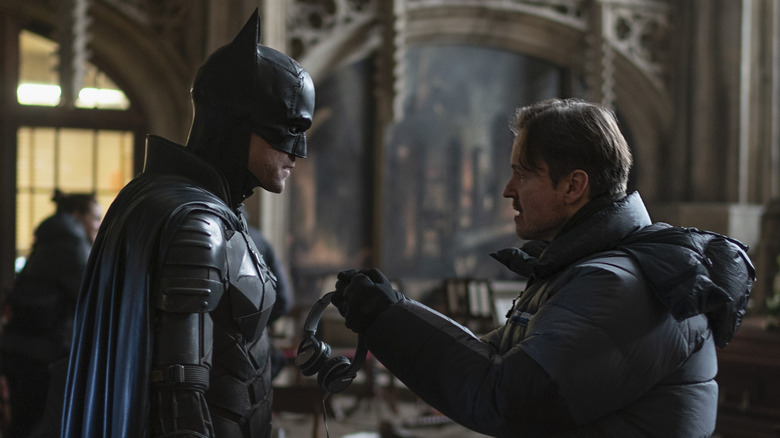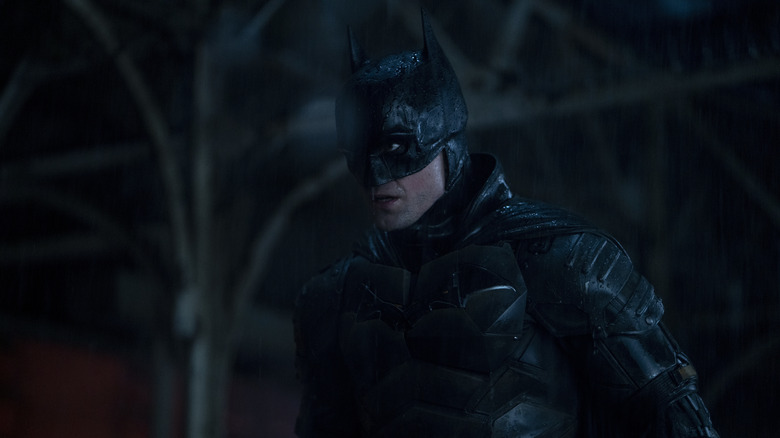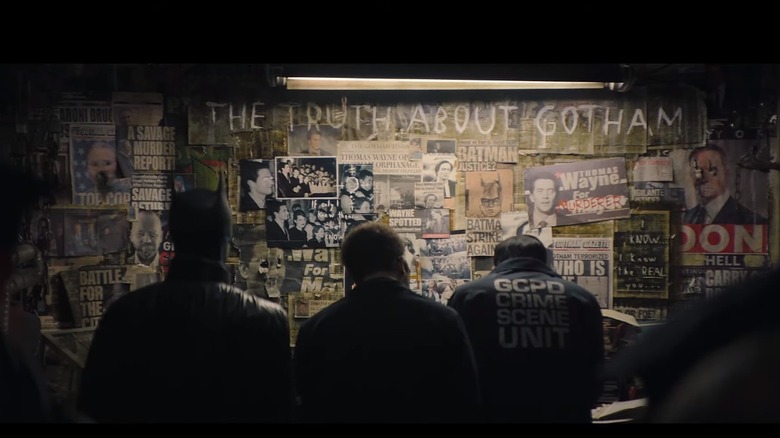Matt Reeves Went Out Of The Box To Capture The Batman's 'Beautiful Imperfections'
The world has been full of superhero movies for well over a decade now, with no signs of the trend slowing down in the future. But one of the biggest of the big superheroes around recently got quite the makeover in "The Batman," which sees Robert Pattinson in the cape and cowl with director Matt Reeves ("Cloverfield," "Dawn of the Planet of the Apes") behind the camera. It turns out, Reeves went through pretty intensive lengths to make this latest entry in the long-running franchise stand out amongst other superhero films. So much so that he used some pretty unconventional filmmaking techniques to achieve the "beautiful imperfections" (as Reeves calls them) we see on screen.
A '70s throwback feel
Reeves reunited with cinematographer Greig Fraser for "The Batman," with the two first having worked together on "Let Me In." Rather than try to emulate the "hyper-realistic" look of most superhero blockbusters today, Reeves and Fraser wanted a gritter, old-school feel, as it suits the version of Gotham City that was crafted for Pattinson's Caped Crusader to occupy. Speaking with CinemaBlend, the filmmaker offered a window into just how far he and Fraser went, and through unconventional means, to achieve the look people see in theaters:
"So Greig tested all these lenses, and I said I wanted to shoot the movie anamorphic, and we had shot 'Let Me In' anamorphic, and I wanted to use that style, and we wanted to bring in this level of, sort of, texture and visceral grit, and visual grit. And Greig deliberately sought out the most technically flawed anamorphic lenses you could possibly have. Because I was really obsessed with the kind of '70s filmmaking that was kind of like, in the vein of, the tone that I thought was our movie, that was kind of like 'The French Connection,' or like 'Klute,' like these neo-noir films that were shot, in many cases, anamorphic. And the lenses at that time, they were rough. They did not, the whole idea was to get the widescreen experience. But in order to do that, the elements came together in a way that there were a lot of really, really beautiful imperfections. And so we wanted to pull as much of that in as possible. And once we kind of tested the range of lenses, I had them take those focal lengths designed to those lenses – we didn't have an 80 or an 85, we had an 88, because there was something wrong with it. Literally, the camera house said to us, 'You don't want these lenses.' And we were like, 'Yeah, yeah. No, we do. We like these lenses.'"
This is not meant to lower one to raise the other, but this is the polar opposite of something like "Batman v Superman: Dawn of Justice" or "Avengers: Endgame." This is not a digital world filled with polished CGI. There are no mythical monsters that Batman is fighting and the look needed to match what was on screen. So yes, they did want those lenses that captured imperfections and they did want some grit to go along with the visuals. This movie needed to have a distinct feel for Reeves, who had the unenviable task of rebooting this beloved character once again.
They went even further
Believe it or not, that doesn't fully cover the lengths that Reeves and Fraser traveled to make "The Batman" look like "The Batman." In speaking to The Ringer about crafting the film, the director revealed that they did even more work well beyond the lenses to offer some further texture and imperfection to the finished product:
"We even did a thing which Greig started on 'Dune' but we took further where we took the finished digital image and we ran it up to film, and then we scanned it back. In 'Dune,' they did a thing where they ran the negative and pulled it back. We did also an IP (interpositive film) so that it was one further generation away, and we did bleach bypass."
It's not necessarily important to understand all of the filmmaking techniques there but, very basically, they printed the digital image onto actual film and used a special process called a bleach bypass. This is used to maintain the levels of silver in the shot. It accomplishes a high-contrast, faded look that isn't inherent in a crisp, digital image. David Fincher has used this technique in the past on movies such as "Fight Club," as did Steven Spielberg for "Saving Private Ryan."
All of this to say: a great deal of thought and technique went into making this movie stand out amongst the crowd and, for their efforts, we got a superhero movie that looks unlike anything else in the modern era.
"The Batman" is in theaters now.


